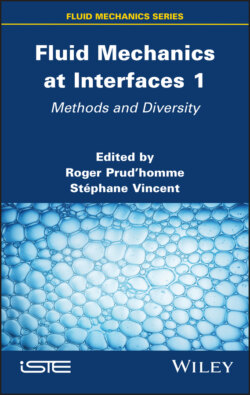Читать книгу Fluid Mechanics at Interfaces 1 - Группа авторов - Страница 9
Оглавление
Preface
In this book, it is relevant to recall the general objectives of the Systems and Engineering e-journal Thermodynamics of Interfaces and Fluid Mechanics1. The thermodynamics of interfaces and fluid mechanics deals with interfaces, thin spaces that separate media with different properties. These interfaces can denote phase separations, as well as thin flames and discontinuity waves. On a microscopic scale, they can be compared to physical surfaces that are endowed with thermodynamic properties and possess their own constitutive laws. The analysis of systems that contain interfaces involves scale changes and the use of specific techniques, such as asymptotic expansions, the second gradient theory and phase field models. Numerical simulations are used to solve the complex systems studied. Experimentation is an essential step in solving the problems posed. The 2D manifolds that the interfaces form often coexist with 1D manifolds, such as ligaments (atomization), contact lines (drops placed in a line) or Plateau edges (foam).
The achievement of the general objectives of Thermodynamics of Interfaces and Fluid Mechanics is partly concretized in the first volumes of the Fluid Mechanics at Interfaces series of books. However, the OpenScience journal has a very broad scope and the articles, published here as chapters (reworked by the authors, from French to English, which requires the modification of certain parts of the articles and updated, etc.), represent only a small part of the interface world, the focus resulting from the authors’ choices. The classification of chapters does not follow the chronology of the articles, but has been organized to be coherent.
The first volume, subtitled Methods and Diversity, focuses more on the sciences, with their various methods of analysis, depending on the scales of space, speed and time, from the microscopic or small scale (starting with molecular and nanoscopic scales characteristic of the matter) to the macroscopic (including meso and interstellar scales), as well as their laws (classical mechanics, quantum mechanics and relativity).
The chapters are organized as follows:
Chapter 1 (R. Prud’homme) is an introduction to Fluid Mechanics at Interfaces, and as such, we examine questions raised by the modeling of interfaces in the presence of one or more fluid phases. The following themes are examined: scales of length and time, the definition of interfacial quantities, microscopic and macroscopic balance equations and constitutive laws. These are required to close the systems of equations that we obtain. Solutions are obtained by using asymptotic expansions and the virtual power method.
Chapter 2 (S. Gouénard, S. Vincent, S. Mimouni) studies two-phase flows. While models have already been developed to study liquid–vapor flows that contain both small, dispersed bubbles and large bubbles (the large bubble model coupled with a dispersed model), the literature has been limited, so far, to laminar regimes. The study presented here relates to the action of turbulence in these two-phase flows, taking into account heat exchanges at the interfaces, as occur in the secondary cooling circuits (exchangers) of nuclear power plants. A new model, using the large-eddy simulation method, is presented here.
Chapter 3 (M.-A. Chadil, S. Vincent, J.-L. Estivalèzes) studies an original method for calculating the drag force and thermal transfers in flows around the networks of spherical particles. This chapter also examines numerical approaches in a two-phase fluid/solid medium, using particle-resolved methods, i.e. the size of the particles is greater than that of the cells in the calculation mesh. An original approach is proposed to extract momentum and heat transfers from particle-resolved simulations of particulate flows.
Chapter 4 (R. Prud’homme) studies the relationships between interfaces and critical fluids. The vicinity of the critical liquid–vapor point of pure bodies presents unique behaviors. In particular, the interface between the liquid and its vapor vanishes when passing the critical point. The piston effect replaces the conductive transfer of heat in the vicinity of solid walls in a 1D configuration.
Chapter 5 (D. Beysens) examines shearing that causes Brownian motion anomalies in particles immersed in fluids that are undergoing strong fluctuations close to their critical point.
Chapter 6 (R. Prud’homme) introduces basic concepts related to combustion interfaces. We also examine turbulent and laminar diffusion and premixed gas flames. A brief introduction to the Burke–Schumann problem is given and discussed, along with the calculation of the combustion rate of a thin premixed flame. The question of the combustion of solids such as thermites, plates with parallel flow and solid propellant rockets is also discussed. The appendices include a brief presentation of the Rankine–Hugoniot theory and a historical note on the research carried out in the field of combustion.
The second volume, subtitled Case Studies and Instabilities, is devoted to the study of the applications to one-, two- and three-dimensional spaces, gaseous and liquid physical states, supercritical fluids and single- or multi-phase systems that may be pure or mixed.
We will study the turbulence in discrete mechanics, atomization under an acceleration field, numerical simulations of tubes with sudden contraction, the evaporation of drops subjected to High Frequency disturbances, possible causes of instabilities in injection engines and flow in a Savonius wind turbine.
This series may seem a little eclectic in its study of different themes in such a vast field, and the topics are, indeed, quite diverse. However, the contents are determined by the release of articles from the OpenScience journal. We hope, of course, that other volumes will be published that will complement this diversity, and, indeed, we wish to address other themes that may be missing here, such as foam, solidification of metals or alloys, plasma in two-phase media, four-dimensional interfaces (if we consider space-time and electromagnetic fields) and so on.
Roger PRUD’HOMME
Stéphane VINCENT
Christian CHAUVEAU
Mahouton Norbert HOUNKONNOU
November 2021
1 1 To consult these articles, see: https://www.openscience.fr/Thermodynamique-des-interfaces-et-mecanique-des-fluides.
